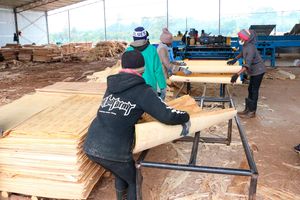Is REDD+ a suitable pillar for Africa's environmental conservation?

The Aberdare ecosystem showing gradual conversion of land from forestry into agriculture and other related human activities.
What you need to know:
- The African Union reports that the continent loses approximately 3.5 million hectares of forest annually, roughly twice the global rate.
- Over 12,000 hectares of forest cover in Kenya are lost yearly due to activities like agricultural expansion and charcoal production.
In the heart of Africa, where forests serve as carbon sinks and the backbone of many ecosystems, REDD+ has emerged as a critical strategy in the global fight against climate change. REDD+ stands for Reducing Emissions from Deforestation and Forest Degradation, plus the role of conservation, sustainable management of forests, and enhancement of forest carbon stocks. It represents an international framework designed to protect forests while rewarding countries and communities for their conservation efforts.
Forests are our planet's lungs, absorbing carbon dioxide and releasing oxygen. In Africa, they represent lifelines, from the Congo Basin's dense rainforests to Kenya's vital water towers like the Mau Complex. These ecosystems sustain biodiversity, regulate rainfall patterns, and support millions of livelihoods. Yet, ongoing deforestation and degradation threaten them, releasing stored carbon into the atmosphere and accelerating climate change. This is the challenge that REDD+ aims to address.
At its core, REDD+ operates through a simple principle: creating financial incentives to preserve forests rather than cutting them down. Since forests act as carbon sinks, absorbing more CO₂ than they emit, their destruction releases stored carbon, contributing significantly to global warming. REDD+ flips this script by rewarding those who protect forests, thereby reducing emissions. The concept gained momentum in 2005 when tropical countries proposed integrating forest protection into global climate agreements. By 2007, the United Nations officially incorporated REDD+ into climate negotiations.
REDD+ implementation follows a phased approach. The readiness phase involves developing national strategies, building capacity, and establishing monitoring systems. The implementation phase follows, where countries enact strategies and demonstrate results-based actions. Finally, the results-based phase involves payments for verified emission reductions. This structured approach ensures that participating countries develop the capability to manage their forests sustainably while receiving financial incentives for their efforts.
This happens through carbon markets or donor-funded programmes. A country or community measures how much carbon their forest stores and then commits to protecting it. If they succeed, they earn carbon credits equivalent to the emissions avoided. These credits can be sold to governments or companies looking to offset their carbon footprints. The resulting revenue funds forest conservation, community projects, or sustainable development initiatives.
The African context makes REDD+ particularly relevant. The African Union reports that the continent loses approximately 3.5 million hectares of forest annually, roughly twice the global rate. Over 12,000 hectares of forest cover in Kenya are lost yearly due to activities like agricultural expansion and charcoal production. The African Forest Forum emphasises REDD+'s importance in addressing this by promoting sustainable forest management and enhancing forest carbon stocks.
Kenya's experience provides valuable insights into REDD+ implementation. The Kasigau Corridor REDD+ project in southeastern Kenya, for example, is noted for its significant environmental and social impacts. This includes protecting over 200,000 hectares of forest, generating substantial carbon credits, and supporting local communities through infrastructure development and job creation.
REDD+ functionality depends on monitoring systems like satellites to track deforestation rates and ground teams to measure tree density and health, while independent auditors certify the results. However, this process isn't foolproof. Critics argue that some projects overestimate carbon savings or fail to address underlying drivers of deforestation such as poverty or illegal logging. There's also the risk of ‘leakage’, where protecting one forest shifts destruction to another area.
Equity concerns also surround REDD+ implementation. While revenue should ideally flow to indigenous communities and local stakeholders who protect forests, disputes over land rights and unclear benefit-sharing mechanisms can marginalise vulnerable groups. A 2021 study in the Congo Basin found that while REDD+ projects increased awareness of forest conservation, some communities felt excluded from decision-making processes. This highlights the need for transparent governance and respect for traditional land rights, a point emphasised in Kenya's National REDD+ Strategy.
The volatility of carbon markets presents another challenge. Credit values depend on demand, which fluctuates with climate policies and corporate priorities. Some critics argue that carbon offsetting allows polluters to ‘buy their way out’ of reducing emissions at the source.
Still, REDD+ aligns with Africa's broader priorities. While contributing less than four per cent of global emissions, the continent faces disproportionate climate impacts, mainly erratic weather patterns. By preserving forests, African nations can mitigate climate change while boosting resilience. Healthy forests regulate local climates, prevent soil erosion, and support agriculture, which employs over 60 per cent of Africans.
Kenya has pledged to restore 5.1 million hectares of degraded land by 2030 under the African Forest Landscape Restoration Initiative. REDD+ investments could accelerate this effort by funding tree-planting and sustainable land-use practices. However, success will depend on balancing environmental and human needs. In areas like Aberdare Ranges, where illegal logging persists due to high demand for charcoal, REDD+ initiatives must offer alternative livelihoods to gain community support.

